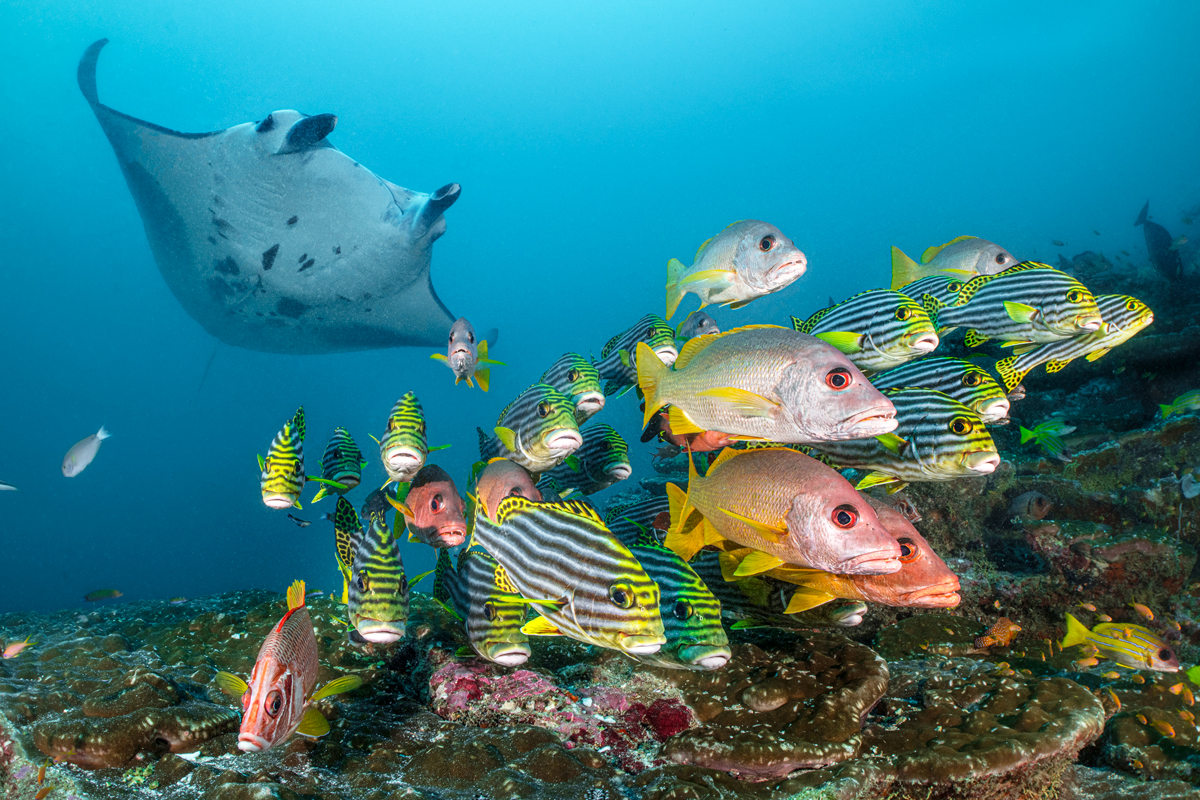How to Take Underwater Photos in the Maldives
Remote and otherworldly, the Maldives is a 500-mile-long double chain of atolls, reefs and small castaway islands, sitting just north of the equator in the Indian Ocean. The region has two distinct monsoon seasons. The mantas migrate with the monsoons, which can be important if you want to see an active cleaning station close to a specific resort.
Tip 1: Flexible Friendly
The Maldives rewards the adaptable photographer. Strong currents pump water in and out of the many atolls, and with such complex underwater topography, including countless submerged thila reefs, diving conditions are tough to predict. Outgoing tides can often suck surprisingly murky water onto a dive site, and the current can shut off when you least expect it, causing the soft corals to close up, the schools to disperse and the photographic potential to drain away.
There’s one big diving choice you’ll have to make: liveaboard or land-based. Liveaboards give access to a wider range of dive sites, while resorts have the bonus of relaxing house-reef diving and give the island-escape experience that defines this country. Whichever you choose, most diving is done from a dhoni (local wooden boat). So even though dive guides always check the conditions, as an underwater photographer you are locked into diving with the lens that you chose earlier. For this reason, the flexible wide-angle zoom is your lens of choice.
There are thousands of dives in the Maldives, and choosing those most suitable for photography will greatly increase your productivity. Many popular sites are fast drift dives where you will see amazing life, but mostly flying by, out of photographic range. Joining a trip with other photographers will mean the whole boat wants to visit the more photo-friendly spots. Even so, get ready to adapt techniques to suit what you find, and take it on the chin when you jump in with a macro lens and find yourself face-to-face with a whale shark!
Tip 2: Sensational Subjects
There are lots of endemic species in the Maldives, and everyone should go home with photos of the ubiquitous Maldivian anemonefish. The reefs are best known for simply being fishy, which is something you should always try to communicate in your photos. Schooling fish make excellent subjects in themselves.
The best images feature neatly aligned fish—and the current can be a big help. Schooling fish are also ideal for backgrounds, so when the water column is packed with life, drop down to the reef to hunt out a foreground.
Many reefs also have healthy reef shark populations. Gray reefs gather in numbers on many sites and will come into photo range with patience. A snorkel from most resort islands will get you close to reef blacktips. Whale sharks can be encountered reliably in South Male Atoll and sometimes come and feed on plankton attracted to the liveaboard lights at night. Tawny nurse sharks appear for a popular night dive in Vaavu Atoll, and tiger sharks show up for a wild rodeo, attracted to the tuna factory in Fuvahmulah Atoll.
Turtles are common. Hawksbills are found on most dive sites, and every now and then you will find a particularly friendly individual. Green turtles tend to be more patchy, rare until encountered in good numbers on certain sites, such as Kuredu Caves. Their particularly pretty shells work well when photographed from above, or if they are resting, their characterful faces make for memorable portraits.
But reef manta rays are the classic Maldivian subject. There are many manta dives across the atolls; most are at cleaning stations, where the giant rays come in for their spa treatment.
Great photos come with patience and good behavior from the whole dive group. Stay low and don’t block access to the cleaning station. Then the mantas will often come right overhead and stay in orbit for the rest of the dive. Despite the rays often filling the frame, generally you want your strobes right out on long arms for these dives, to minimize backscatter when trying to illuminate such big creatures. If the rays aren’t coming so close to you, then adapt and look for a colorful foreground subject, like an anemonefish, a soft coral or schooling fish, and use the mantas as a background.

When you subscribe to the blog, we will send you an e-mail when there are new updates on the site so you wouldn't miss them.
